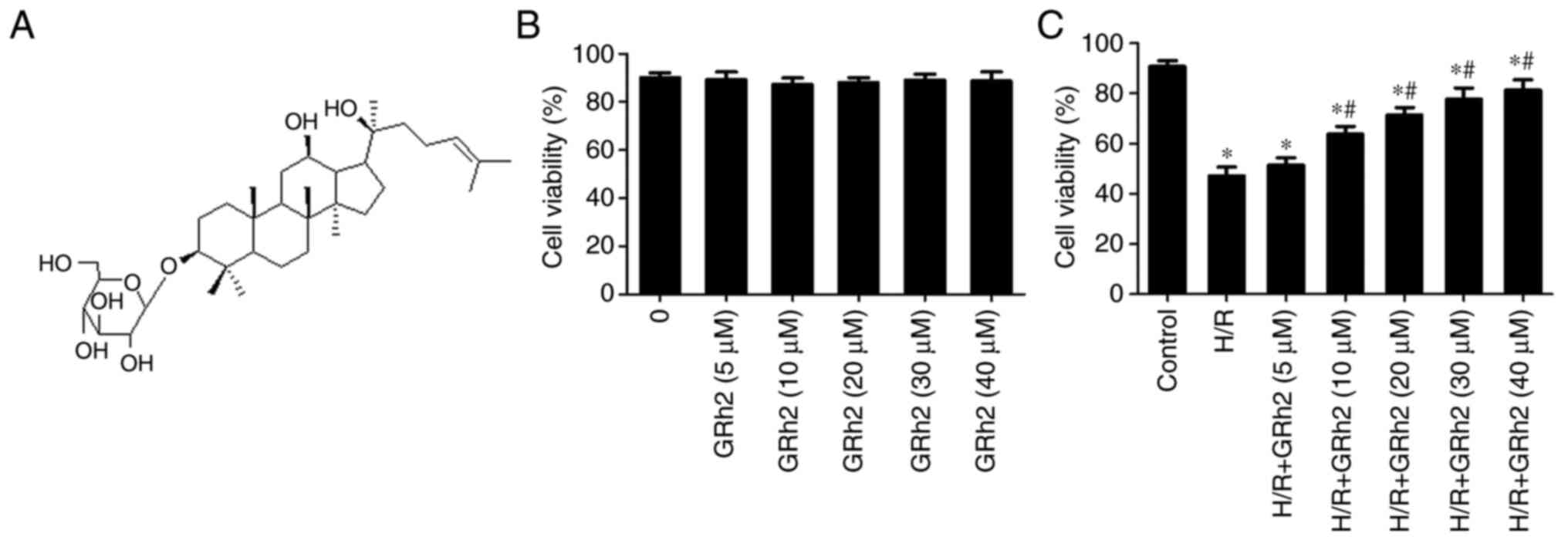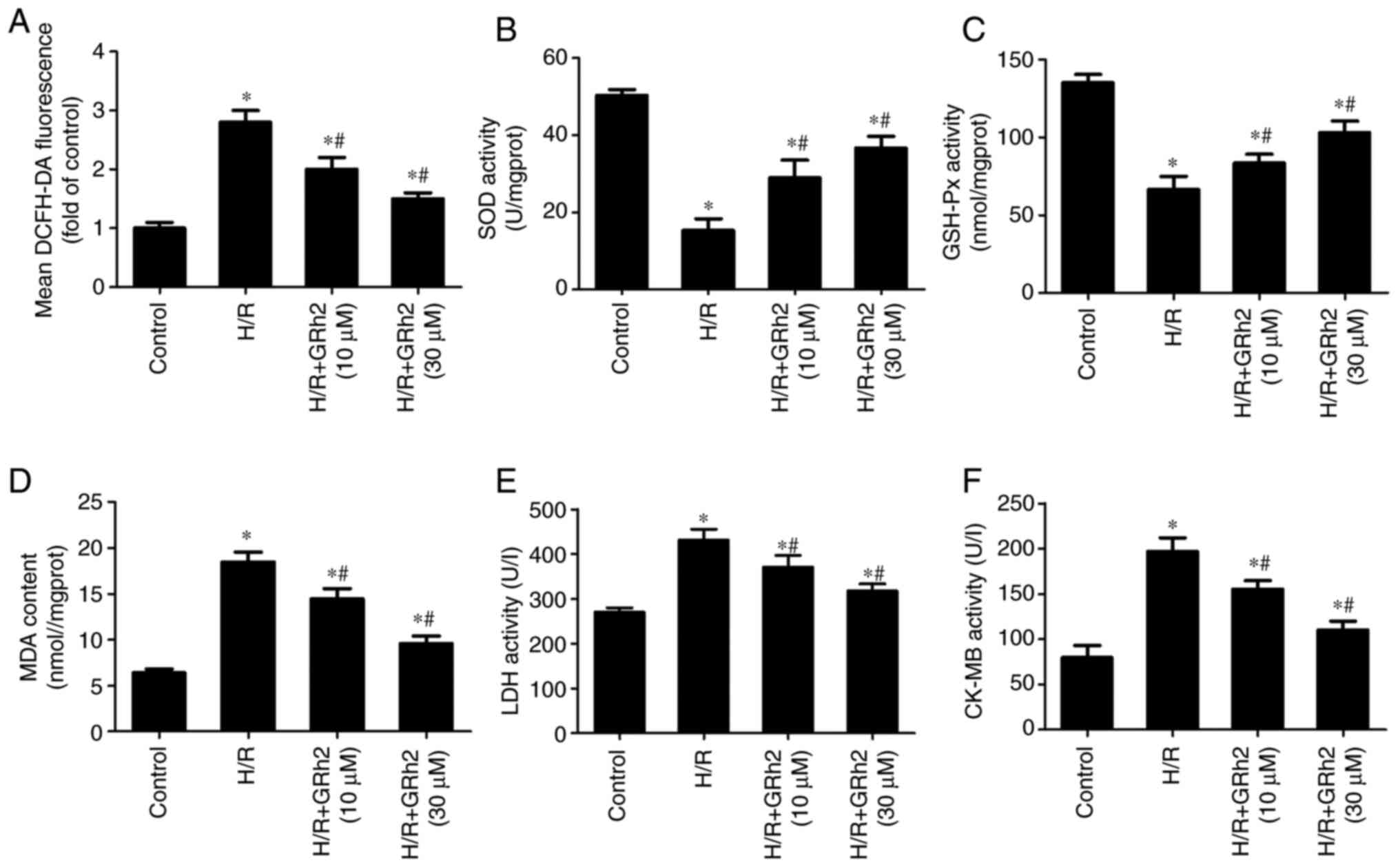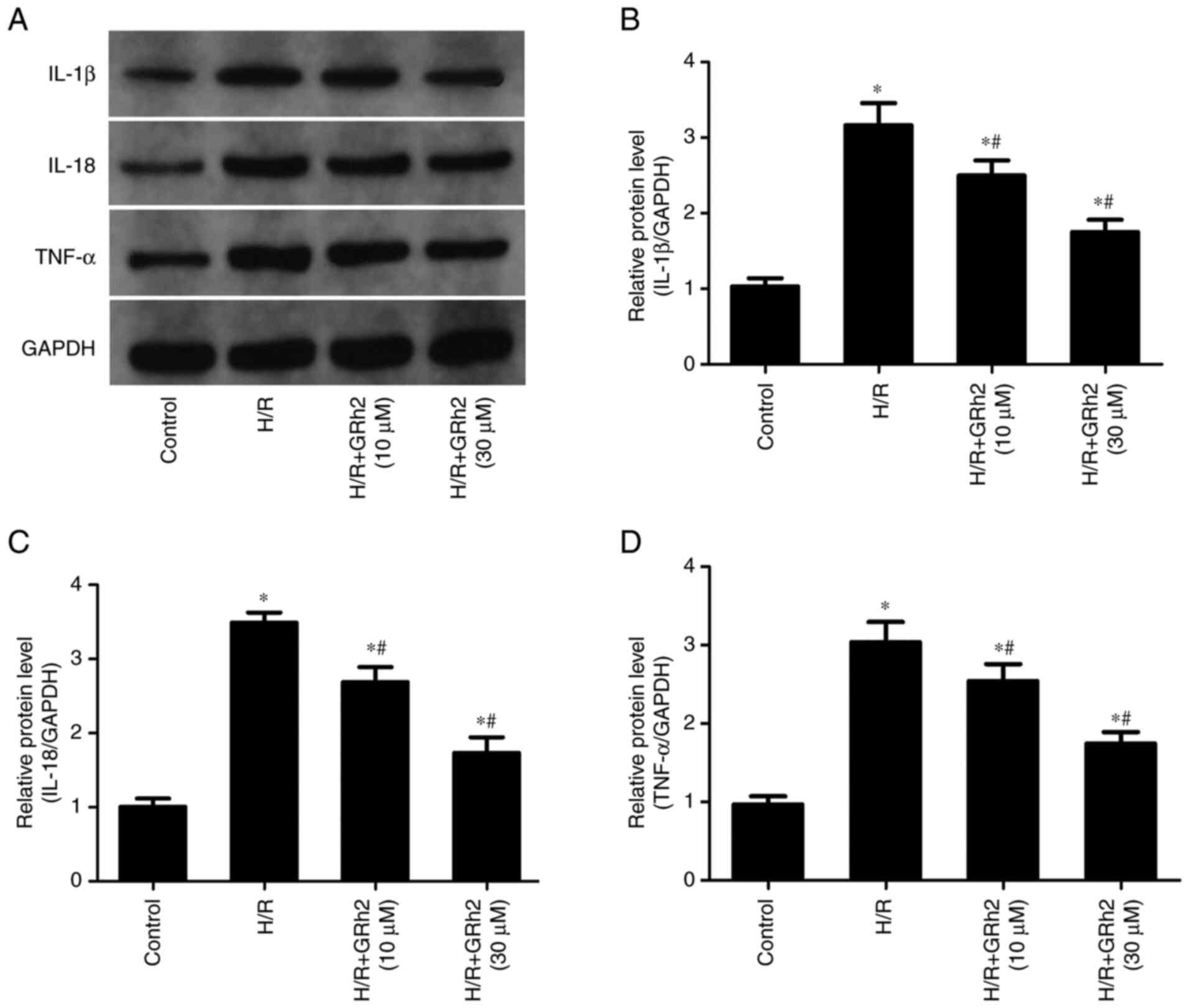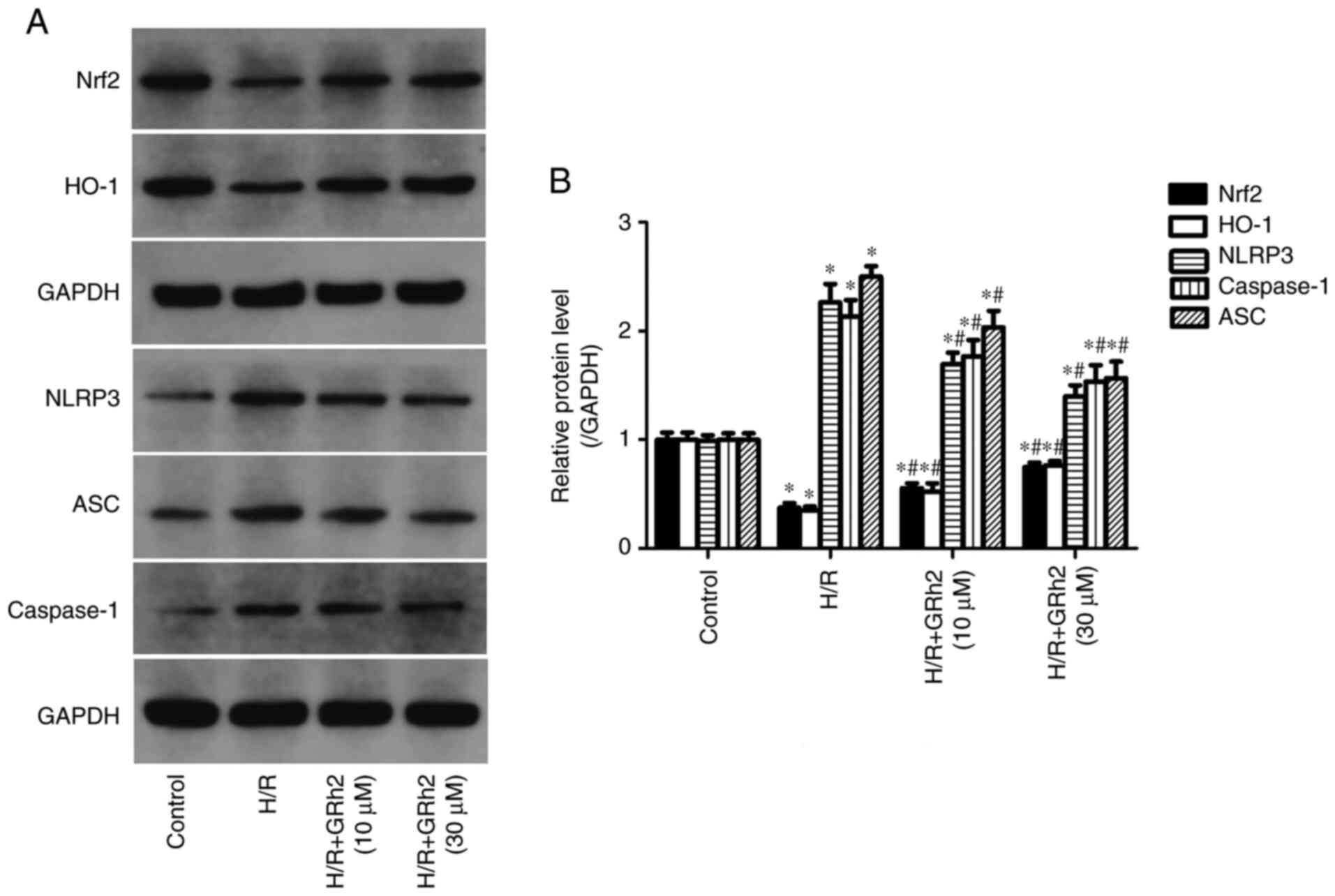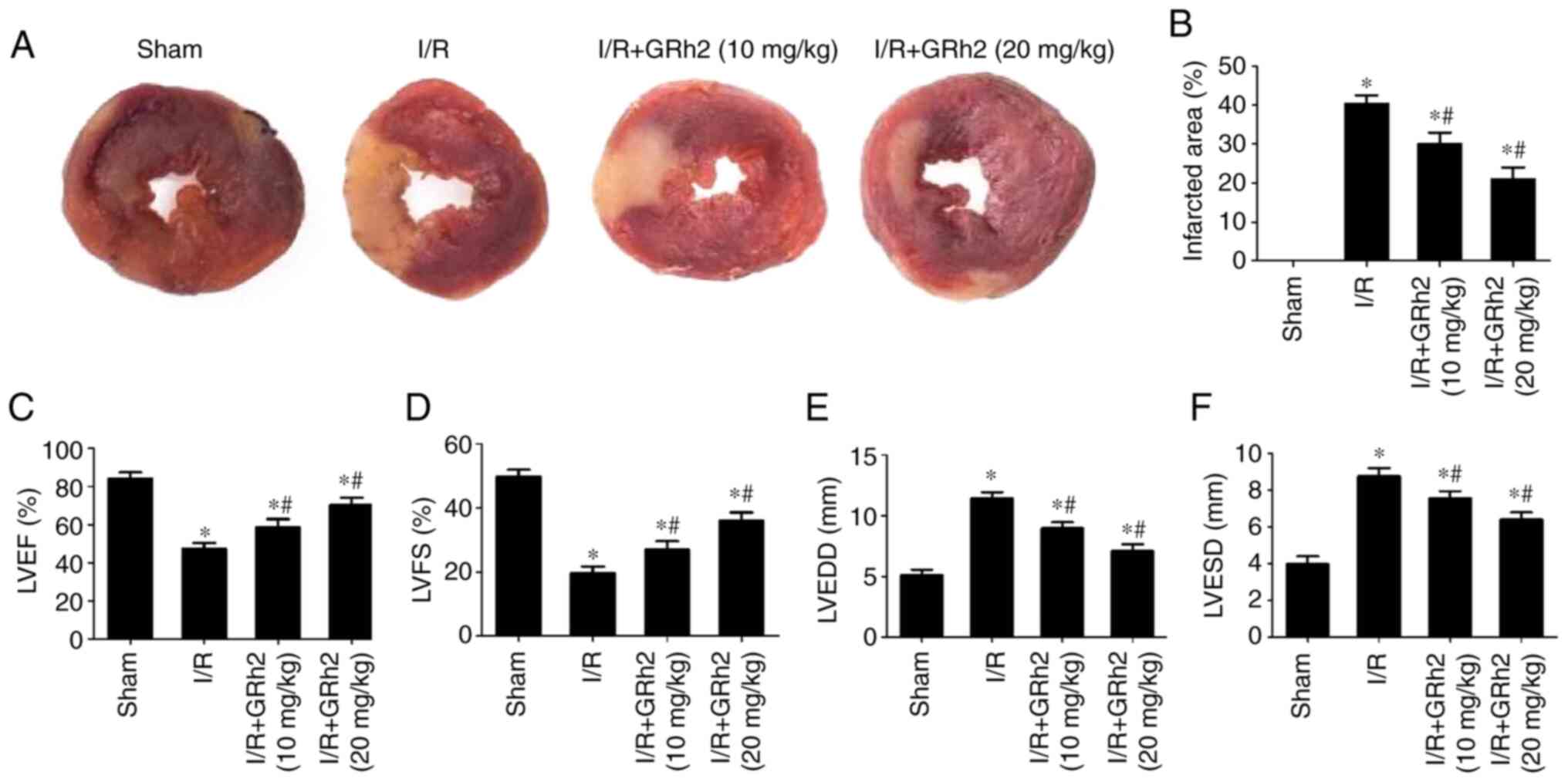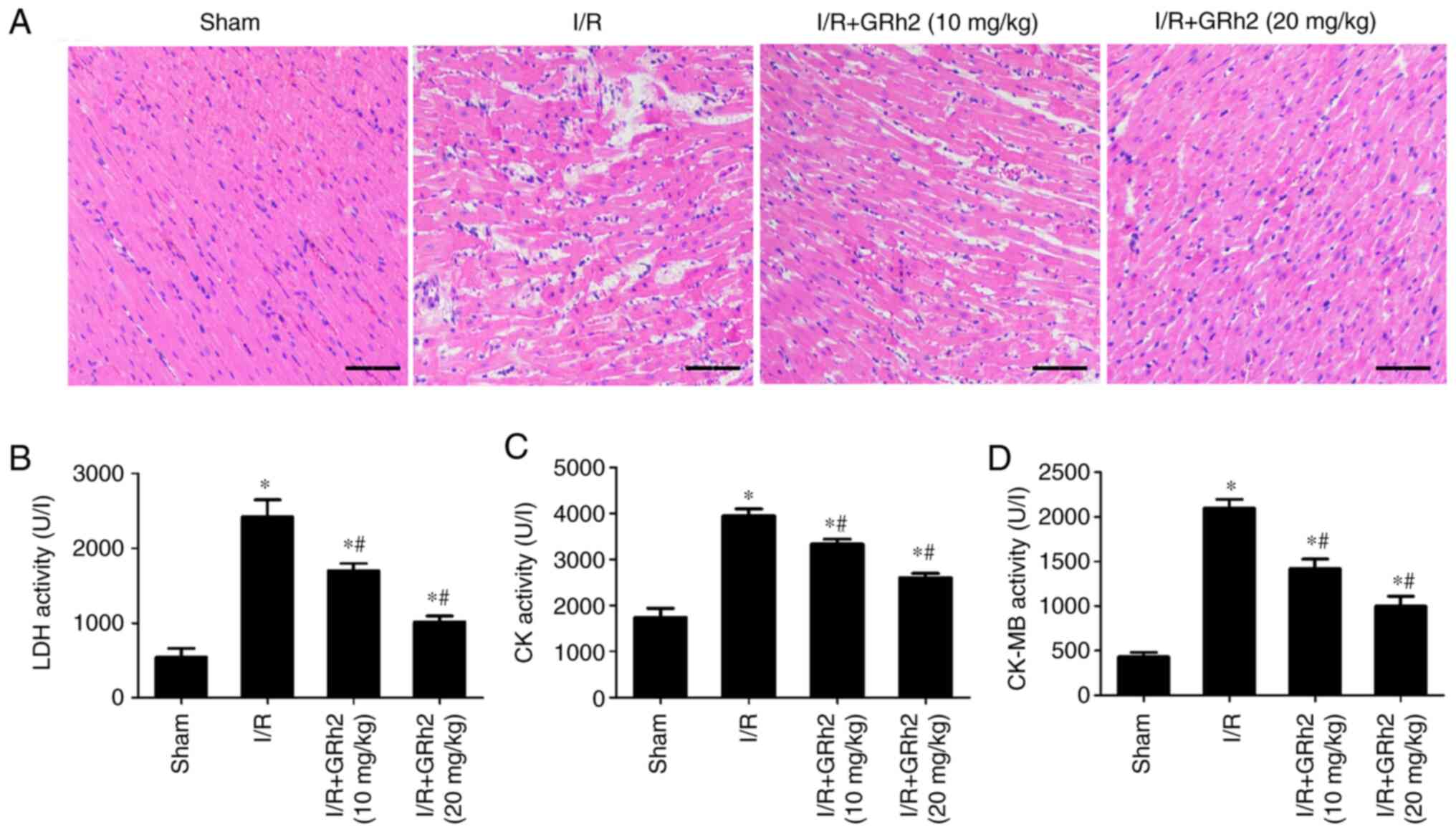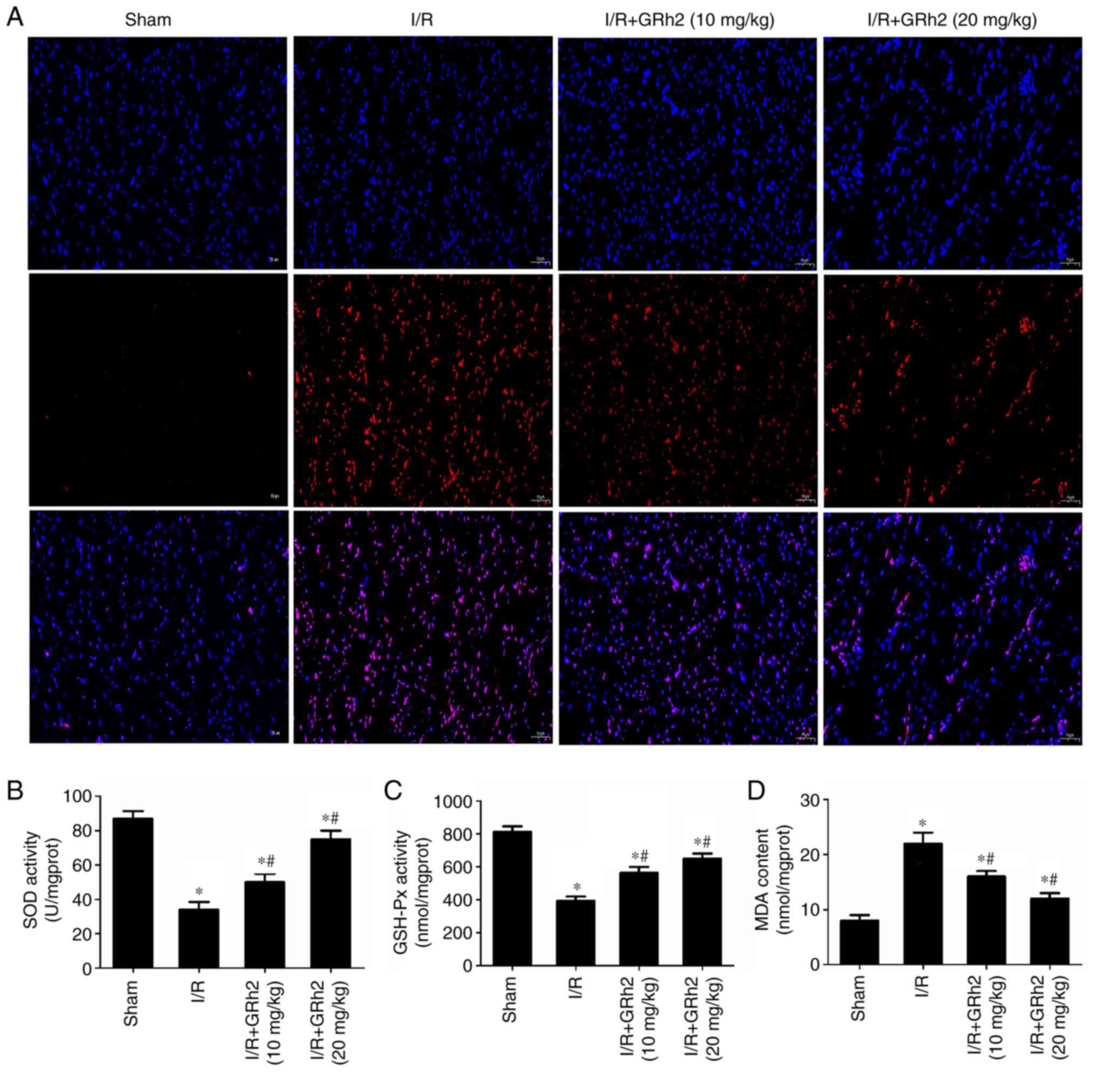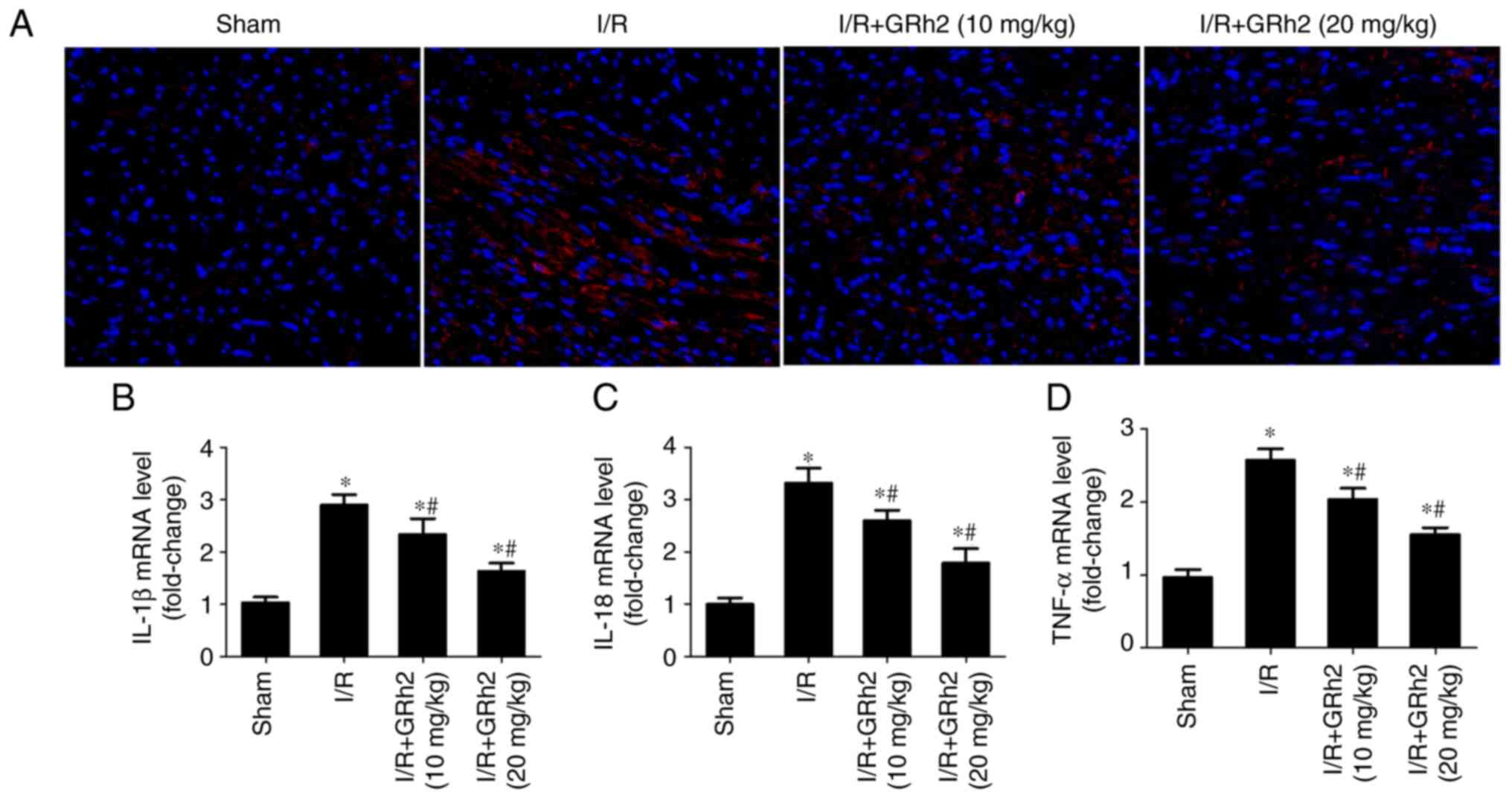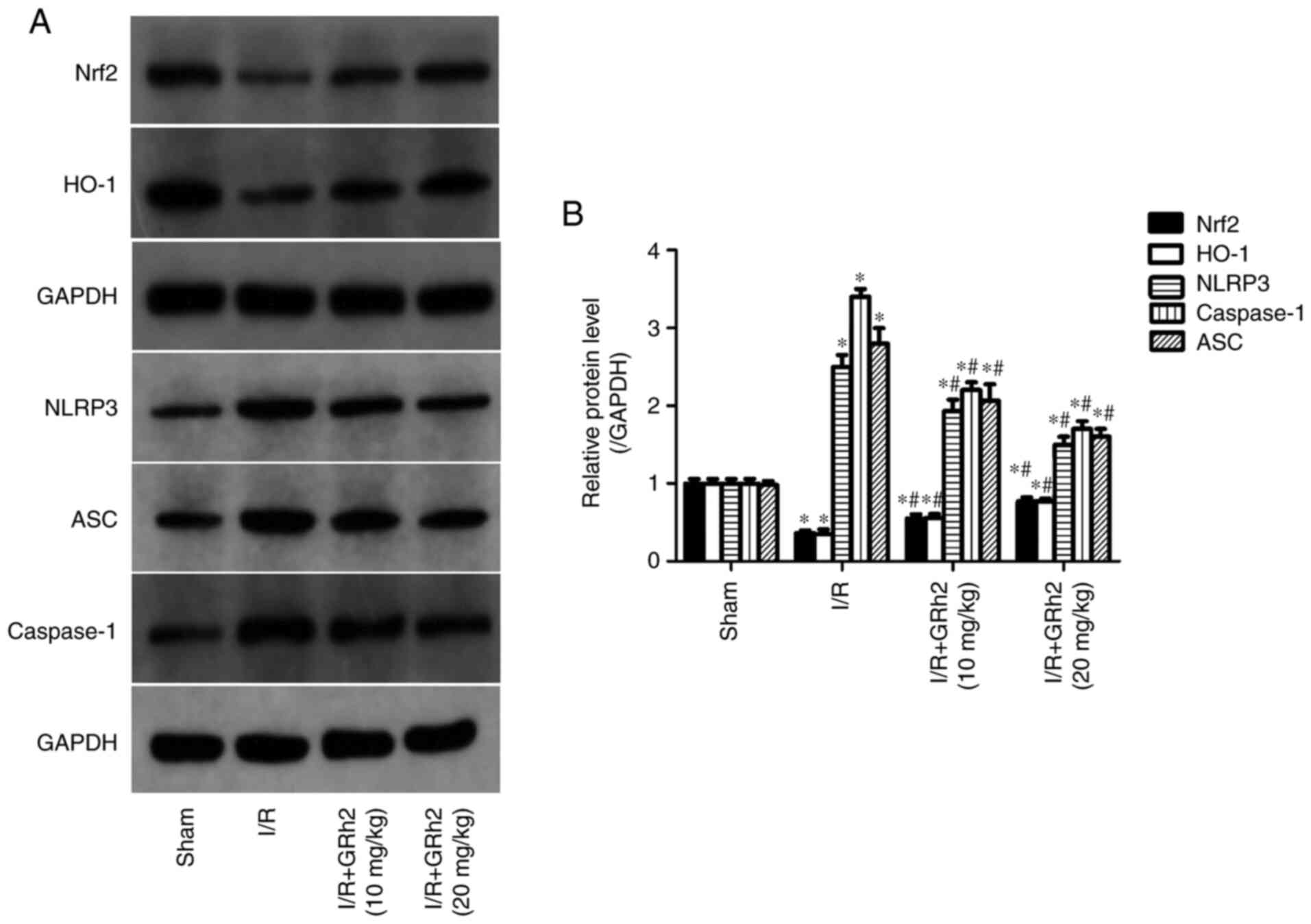Ginsenoside Rh2 attenuates myocardial ischaemia‑reperfusion injury by regulating the Nrf2/HO‑1/NLRP3 signalling pathway
- Authors:
- Published online on: November 29, 2022 https://doi.org/10.3892/etm.2022.11734
- Article Number: 35
-
Copyright: © Fan et al. This is an open access article distributed under the terms of Creative Commons Attribution License.
Abstract
Introduction
With changes in lifestyle, the incidence (23.57% in 2018) and mortality rate (298.42/100000 in 2018) of cardiovascular diseases are still rising (1). Among them, coronary heart disease (CHD) has become a disease with a high mortality rate (128.24/100000 in 2018) worldwide (2). Early revascularization is the preferred treatment strategy for CHD; however, the resulting myocardial ischaemia-reperfusion (I/R) injury (MIRI) is a main factor leading to ventricular dysfunction and affects long-term prognosis of patients (3).
MIRI has a complicated pathological mechanism. Studies have shown that oxidative stress and the inflammatory response play important roles (4,5). The increase in reactive oxygen species (ROS) during I/R cannot only affect the functions of mitochondria and promote the occurrence of apoptosis but also mediate inflammatory cascades and aggravate myocardial damage (6). Previous studies have found that a single treatment for oxidative stress or inflammation can alleviate MIRI to varying degrees (7,8). However, since MIRI is a pathophysiological process mediated by multiple signalling pathways and multiple transcription factors, a single intervention with a regulatory factor cannot fully exert its protective effect on I/R in the myocardium (9). Oxidative stress and the inflammatory response are critical in regulating MIRI through multiple genes. Effectively relieving myocardial inflammation and oxidative stress simultaneously could provide a new prevention and treatment strategy for fully and effectively reducing MIRI.
The chemical components of ginseng are very complex. Ginsenoside is the main component in ginseng and has attracted the attention of researchers (10). As a monomer isolated from red ginseng, Ginsenoside Rh2 (GRh2) has high biological safety and antitumour, antiasthma and antiallergy functions (11). Due to its wide range of pharmacological effects, GRh2 has gained interest due to its protective effects in diseases (12,13). Hsieh et al (12) found that GRh2 could alleviate the oxidative stress caused by lipopolysaccharide-induced acute lung injury by activating the nuclear factor E2-related factor 2 (Nrf2)/heme oxygenase-1 (HO-1) signalling pathway. Ma et al (13) also revealed that GRh2 could slow the development of inflammatory diseases by inhibiting the activation of NLRP3 inflammasomes. Therefore, based on the pharmacological properties of GRh2, it was hypothesized that GRh2 can protect the myocardium against I/R through antioxidation and anti-inflammatory effects. However, the role and mechanism of GRh2 in MIRI have not yet been elucidated. In the present study, the effect of GRh2 on I/R in the myocardium was observed and its molecular mechanism was further explored to provide more effective prevention and treatment strategies for MIRI.
Materials and methods
Reagents
GRh2 (Fig. 1A) was purchased from Chengdu Must Bio-Technology Co., Ltd. (purity >98%; cat. no. A0241). Lactate dehydrogenase (LDH; cat. no. A020-1-2), creatine kinase (CK; cat. no. A032-1-1) and creatine kinase-myocardial band (CK-MB; cat. no. E006-1-1) biochemical kits were purchased from the Nanjing Jiancheng Bioengineering Institute. 2,3,5-Triphenyltetrazolium chloride reagents (TTC; cat. no. T8877) were purchased from Sigma-Aldrich (Merck KGaA). Cell Counting Kit-8 (CCK-8; product code CK04) was purchased from Dojindo Laboratories, Inc. Malondialdehyde (MDA; cat. no. S0131S), superoxide dismutase (SOD; cat. no. S0101S) and glutathione peroxidase (GSH-Px; cat. no. S0056) kits were purchased from Beyotime Institute of Biotechnology. Dimethyl sulfoxide (DMSO) was purchased from MP Biomedicals, LLC (MPBIO; cat. no. MP0219605591). An intracellular ROS detection kit with DCFH-DA (cat. no. MAK144) was purchased from Sigma-Aldrich; Merck KGaA. The fluorescent probe dihydroethidium (DHE) was purchased from Invitrogen; Thermo Fisher Scientific, Inc. The protein primary antibodies against Nrf2 (1:800; cat. no. ab92946), HO-1 (1:600 dilution, product code ab13243), NOD-like receptor family pyrin domain-containing 3 (NLRP3; 1:1,000 dilution, product code ab214185), apoptosis-associated speck-like protein (ASC; 1:1,000; cat. no. ab180799), caspase-1 (1:1,000 dilution, product code ab179515), interleukin (IL)-1β (1:500; cat. no. ab9722), IL-18 (1:500 dilution, product code ab191860) and tumor necrosis factor (TNF)-α (1:200 dilution, product code ab205587) were purchased from Abcam. The protein secondary antibody goat anti-rabbit IgG (1:2,000 dilution, product code ab205718) was also purchased from Abcam.
Neonatal rat cardiomyocyte (NRCM) culture and establishment of a hypoxia/reoxygenation (H/R) model
NRCMs were isolated from ~2-day-old Sprague-Dawley (SD) rats (six rats) provided by the Experimental Animal Center of China Three Gorges University (Yichang, China). The SD rats were anaesthetized, and their hearts were quickly removed. The obtained heart tissues were rinsed with ice-cold phosphate-buffered saline (PBS) solution to remove any residual blood. Then, 0.08% collagenase type II and 0.125% trypsin were used to digest the tissues at 37˚C for 7 min. Finally, the NRCMs were centrifuged (1,000 x g at 4˚C for 10 min) and resuspended in Dulbecco's modified Eagle's medium (DMEM; Gibco; Thermo Fisher Scientific, Inc.) with 10% foetal bovine serum (FBS; Gibco; Thermo Fisher Scientific, Inc.) and 1% penicillin/streptomycin at 37˚C with 5% CO2 and 95% O2. Cells no older than passage 5 were used in the H/R experiments. Briefly, cultured NRCMs were preserved in serum-free DMEM at 37˚C for 12 h. Then, the NRCMs were incubated in an anaerobic chamber (95% N2-5% CO2) at 37˚C for 4 h. The NRCMs were moved into a normal incubator (37˚C) for an additional 4 h to induce reoxygenation. The primary cardiomyocytes were randomly separated into the following groups: Control, H/R, and H/R+GRh2 (with different concentrations of GRh2 pre-treatment 24 h before H/R). Each experiment was repeated ≥5 times.
Cell viability assay
A Cell Counting Kit-8 (CCK-8) kit was used to detect the viability of NRCMs according to standard procedures. The cell density was 5x103 cells/well. The volume of CCK-8 was 10 µl for each well (incubation for 2 h at 37˚C). The CCK-8 optical density (OD) at 450 nm was recorded.
Animal experimental design
A total of 40 male SD rats (aged ~8 weeks) were provided by the Experimental Animal Center of China Three Gorges University (Yichang, China). The rats were housed at 23±2˚C with 50% relative humidity, 12-h light/dark cycles and free access to water. The rats were divided into the following four groups: The sham group, the I/R group, the I/R+GRh2 (10 mg/kg) group and the I/R+GRh2 (20 mg/kg) group. Ten days before the construction of the I/R models, continuous intragastric administration was initiated in the GRh2 group. In the sham and I/R groups, an equal volume of DMSO was administered by intragastric administration. For the establishment of the I/R model, the rats were administered abdominal anaesthesia (30 mg/kg pentobarbital sodium) and fixed. Ventilation was provided through the assistance of a ventilator. The chest of each rat was opened between the third and fourth ribs of the left sternum to fully expose the heart. A 4-0 silk suture covered with a latex tube at a diameter of 0.5 cm was used to pass through the initial segment of the left anterior descending artery (LAD). After tightening the silk suture to block the LAD for 0.5 h, the silk suture was cut, and then, reperfusion was performed for 24 h. Changes in the electrocardiogram (ECG) of each rat were observed using a small animal ECG machine; the changes in the ST-T elevation (tightening the silk suture) and ST-T decrease (cutting the silk suture) indicated that the models were constructed successfully. All experimental procedures were approved (approval no. 2020090B) by the Ethics Committee of Experimental Animals of China Three Gorges University (Yichang, China).
Ultrasonography
After reperfusion, the rats were fixed on insulation pads. Then, the anterior chests of the rats were depilated, and the rats were subjected to cardiac ultrasonography. The left ventricle ejection fraction (LVEF), left ventricle fractional shortening (LVFS), left ventricular end-diastolic diameter (LVEDD) and left ventricular end-systolic diameter (LVESD) were measured and recorded.
Collection of samples
Following ultrasonography, the peripheral blood and hearts of the rats were collected. Briefly, 2 ml of blood were obtained from the jugular vein and then centrifuged at 500 x g for 8 min at 4˚C. The serum was collected and stored at -80˚C. The rats were euthanized by injecting 10% potassium chloride (75 mg/kg) into the right jugular vein, and their heart tissues were removed and quickly rinsed with normal saline. The left ventricular tissues were cut, and certain myocardial tissue was frozen or fixed with 4% paraformaldehyde for 48 h at room temperature for sectioning. Then, immunofluorescence (IF) staining and haematoxylin/eosin (H&E) staining were performed as described below in the histological analysis. Another portion of the tissue was stored in a freezer at -80˚C for the protein and genetic testing.
Measurement of the infarct area
Following I/R, the abdominal cavity of each rat was reopened, and 1 ml of TTC solution was injected from the inferior vena cava; 10 min later, the heart was removed. After washing the surface of the heart, the heart was frozen at -80˚C for 20 min. Slices were cut along the long axis of the heart at a width of 2 mm. After cleaning, the slices were fixed in 4% paraformaldehyde for 24 h at room temperature. The white area indicates myocardial infarction, and the red area indicates normal myocardial tissue. The white and red areas of the myocardial tissue after the TTC staining were measured by Image-Pro Plus 5.0 software (Media Cybernetics, Inc.). The infarct area was calculated as follows: [White area/(white area + red area) x100%].
Histological analysis
The heart tissues were fixed using 4% paraformaldehyde for 48 h at room temperature. The tissues were embedded in paraffin, cut into 4-µm sections, and subjected to H&E (room temperature, hematoxylin staining, 5 min; eosin staining, 2 min) and IF staining. For the IF staining, the sections were blocked with 1% goat serum (cat. no. 31873; Thermo Fisher Scientific, Inc.) for 30 min at room temperature. Sections were then incubated with a TNF-α antibody (1:200 dilution) at 4˚C for 12 h and subsequently incubated with anti-Rabbit HRP secondary antibody (1:200 dilution, product code ab150079, abcam) at 37˚C for 1 h. After washing with PBS, the sections were counterstained with DAPI (100 ng/ml) at room temperature for 5 min. The sections were examined using a fluorescence microscope and a digital camera (Axio Observer Al; Carl Zeiss AG).
Biochemical index analysis
The activities of the antioxidant enzymes SOD and GSH-Px and the levels of MDA in the heart tissues or NRCM homogenates were determined following the manufacturer's protocol. The activities of LDH, CK and CK-MB in both serum and culture supernatant were assessed using kits according to the instructions.
Detection of ROS
For the detection of ROS in cells, after completing the H/R treatment of the NRCMs, trypsin was added to digest the cells until 95% of the cells were shed as assessed under a light microscope. The digested cells were transferred to a 15-ml Eppendorf tube and centrifuged at 500 x g for 5 min at 4˚C. The supernatant was discarded; under dark conditions, DCFH-DA (cat. no. MAK144) was added to each group and the samples were incubated at 37˚C in the dark for 30 min. After the incubation, the samples were centrifuged at 500 x g for 5 min at 4˚C to discard the supernatant, and then, the cells in each group were gently washed with PBS solution once. After centrifugation at 500 x g for 5 min at 4˚C, the supernatant was discarded, and PBS was added again to resuspend the cells for detection. For the detection of ROS in the tissues, the myocardial tissues were washed with PBS solution, and frozen sectioning was performed immediately. The myocardial slices were incubated with the fluorescent probe DHE (10 µM) for 30 min at 37˚C under dark and humid conditions. After washing twice with PBS solution, the samples were observed under a fluorescence microscope.
Reverse transcription-quantitative PCR (RT-qPCR)
RT-qPCR was performed to detect the mRNA levels. Briefly, TRIzol® reagent (Invitrogen; Thermo Fisher Scientific, Inc.) was used to extract the total RNA from the heart tissues. The obtained RNA (~4.0 µg) was then reverse transcribed into cDNA using SuperScript IV Reverse Transcriptase (Thermo Fisher Scientific, Inc.) at 37˚C for 60 min. Then, qPCR was performed using a SYBR Green Master Mix kit (Thermo Fisher Scientific, Inc.) on a 7500 ABI Prism system (Applied Biosystems; Thermo Fisher Scientific, Inc.). The qPCR thermocycling conditions were as follows: 45˚C for 2 min and 95˚C for 10 min, immediately followed by 45 cycles at 95˚C for 30 sec and 60˚C for 30 sec. The mRNA expression levels were normalized to that of GAPDH. The 2-ΔΔCq method was used to calculate the changes in mRNA expression (14). The following primers were used: IL-1β forward, 5'-CCTGTGTGATGAAAGACGGC-3' and reverse, 5'-TATGTCCCGACCATTGCTGT-3'; IL-18 forward, 5'-CTACCAGCAAACATCTCACTTCAG-3' and reverse, 5'-CAACTGAGAGGCTGTGCCCT-3'; TNF-α forward, 5'-CCGATTTGCCATTTCATACCAG-3' and reverse, 5'-TCACAGAGCAATGACTCCAAAG-3'; and GAPDH forward, 5'-GAACGGGAAGCTCACTGG-3' and reverse, 5'-GCCTGCTTCACCACCTTCT-3'.
Western blot analysis (WB)
The protein levels of Nrf-2, HO-1, NLRP3, ASC, caspase-1, IL-1β, IL-18 and TNF-α were detected by WB. First, the obtained cells or tissues were homogenized. Then, the proteins were extracted using a protein extraction kit (cat. no. P0028; Beyotime Institute of Biotechnology), and the concentrations were determined by the BCA method. To prepare the gels for WB, glass plates were aligned and clamped tightly. After a 12% separation gel solution was prepared, the gel was slowly poured and sealed with water. After the separation gel was solidified, a 4% spacer gel solution was prepared and poured into glass plates, and a comb was placed. After the spacer gel was solidified, the comb was removed. For each group, 50 µg of total protein were used for electrophoresis. After electrophoresis, the gel blocks of the protein bands were cut and transferred to a polyvinylidene difluoride (PVDF) membrane. After the transfer, the PVDF membrane was blocked with 5% skim milk powder at room temperature for 1 h and incubated with a protein primary antibody overnight at 4˚C. On the following day, the PVDF membrane was incubated with a secondary antibody for 1 h at 37˚C and developed according to the relevant instructions of the developing and fixing kit. An enhanced chemiluminescence detection kit (Thermo Fisher Scientific, Inc.) was used for visualization and GAPDH served as a loading control. Odyssey® Infrared Imaging system (model 9120; LI-cOR Biosciences) was used to capture images of the membranes and Quantity One 1-D software (version 4.6.9; Bio-Rad Laboratories, Inc.) was used to quantify the protein bands.
Statistical analysis
SPSS 22.0 software (IBM Corp.) was used for the data analysis. The data are presented as the mean ± SD (n=5). Student's unpaired t-test and one-way ANOVA were used for the comparisons between the groups. If interactions were significant, a Tukey's post hoc test was used for multiple comparisons. P<0.05 was considered to indicate a statistically significant difference.
Results
GRh2 promotes NRCM survival
The effect of different concentrations of GRh2 on the survival rate of NRCMs was evaluated by CCK-8 assay. The results showed that when the concentration of GRh2 was <40 µM, GRh2 had no obvious cytotoxicity (Fig. 1B). After the establishment of the H/R model, it was demonstrated that GRh2 at a concentration ≥10 µM could improve the survival rate following H/R. When the concentration was ≥30 µM, the cell protective effect was obvious and tended to be stable (Fig. 1C). Therefore, 10 and 30 µM GRh2 were selected as the low and high concentrations, respectively, in subsequent in vitro experiments.
GRh2 inhibits H/R-induced oxidative stress in vitro
After the pre-treatment with GRh2, H/R models were established, and indicators related to oxidative stress and myocardial damage were evaluated. Compared with the control group, the levels of ROS (Fig. 2A), MDA (Fig. 2D), LDH (Fig. 2E) and CK-MB (Fig. 2F) were increased in the H/R group. GRh2 reduced the levels of ROS, MDA, LDH and CK-MB, and the reduction in the H/R+GRh2 (30 µM) group was more significant than that in the H/R+GRh2 (10 µM) group. Compared with the control group, the activities of SOD (Fig. 2B) and GSH-Px (Fig. 2C) were decreased in the H/R group. GRh2 increased the activities of SOD and GSH-Px, and the increase in the H/R+GRh2 (30 µM) group was more significant than that in the H/R+GRh2 (10 µM) group.
GRh2 inhibits H/R-induced inflammation in vitro
The results revealed that compared with the control group, the protein expression levels of IL-1β, IL-18 and TNF-α were significantly increased in the H/R group (Fig. 3). The pre-treatment with GRh2 reduced the expression levels of IL-1β, IL-18 and TNF-α, and the decrease in the H/R+GRh2 (30 µM) group was more significant than that observed in the H/R+GRh2 (10 µM) group.
GRh2 participates in the regulation of the Nrf2/HO-1/NLRP3 signalling pathway in vitro under H/R stimulation
Compared with the control group, the protein expression levels of NLRP3, ASC and caspase-1 in the H/R group were significantly increased. GRh2 reduced the expression levels of NLRP3, ASC and caspase-1 and the reduction in the H/R+GRh2 (30 µM) group was more significant than that observed in the H/R+GRh2 (10 µM) group. Compared with the control group, the expression levels of Nrf2 and HO-1 were decreased in the H/R group. The pre-treatment with GRh2 increased the expression levels of Nrf2 and HO-1, and the increase in the H/R+GRh2 (30 µM) group was more significant than that observed in the H/R+GRh2 (10 µM) group (Fig. 4).
GRh2 reduces the area of myocardial infarction and improves heart function in vivo after I/R
Compared with the sham group, the area of myocardial infarction increased after I/R. GRh2 reduced the infarction area, and the reduction in the I/R+GRh2 (20 mg/kg) group was more significant than that observed in the I/R+GRh2 (10 mg/kg) group (Fig. 5A and B). In addition, following I/R, the cardiac ultrasonography data showed that the LVEF (Fig. 5C) and LVFS (Fig. 5D) of the rats in the I/R group were significantly lower than those in the sham group, while the LVEDD (Fig. 5E) and LVESD (Fig. 5F) in the I/R group were significantly higher than those in the sham group. GRh2 improved the heart function of the rats, and the improvement in the I/R+GRh2 (20 mg/kg) group was more significant than that observed in the I/R+GRh2 (10 mg/kg) group.
GRh2 reduces MIRI in vivo
Compared with the sham group, disorder and oedema of the myocardial tissues and inflammatory cell infiltration increased after I/R. GRh2 improved the degeneration and necrosis of myocardial cells, and the improvement in the I/R+GRh2 (20 mg/kg) group was more significant than that in the I/R+GRh2 (10 mg/kg) group (Fig. 6A). Compared with the sham group, the levels of LDH, CK and CK-MB in the I/R group were increased. GRh2 decreased the levels of LDH, CK and CK-MB, and the decrease in the I/R+GRh2 (20 mg/kg) group was more significant than that observed in the I/R+GRh2 (10 mg/kg) group (Fig. 6B-D).
GRh2 inhibits I/R-induced oxidative stress in vivo
Indicators related to oxidative stress were evaluated in I/R myocardial tissues of rats. The results revealed that GRh2 significantly reduced the proportion of ROS-positive cells (Fig. 7A). Compared with the sham group, the activities of SOD and GSH-Px were decreased, and the activity of MDA was increased in the I/R group. GRh2 increased the activities of SOD and GSH-Px and reduced the activity of MDA, and the effects in the I/R+GRh2 (20 mg/kg) group were more significant than those in the I/R+GRh2 (10 mg/kg) group (Fig. 7B-D).
GRh2 inhibits I/R-induced inflammation in vivo
The expression of TNF-α in I/R myocardial tissues of rats was detected by IF. The results revealed that GRh2 significantly reduced the expression level of TNF-α (Fig. 8A). Compared with the sham group, the expression levels of IL-1β, IL-18 and TNF-α in the I/R group were significantly increased. GRh2 reduced the expression levels of IL-1β, IL-18 and TNF-α, and the reduction in the I/R+GRh2 (20 mg/kg) group was more significant than that observed in the I/R+GRh2 (10 mg/kg) group (Fig. 8B-D).
GRh2 participates in the regulation of the Nrf2/HO-1/NLRP3 signalling pathway in vivo
Compared with the sham group, the protein expression levels of NLRP3, ASC and caspase-1 in the I/R group were significantly increased. GRh2 reduced the expression levels of NLRP3, ASC and caspase-1, and the reduction in the H/R+GRh2 (20 mg/kg) group was more significant than that in the H/R+GRh2 (10 mg/kg) group. Compared with the sham group, the expression levels of Nrf2 and HO-1 in the I/R group were decreased. The pre-treatment with GRh2 increased the expression levels of Nrf2 and HO-1, and the increase in the H/R+GRh2 (20 mg/kg) group was more significant than that observed in the H/R+GRh2 (10 mg/kg) group (Fig. 9).
Discussion
Percutaneous coronary intervention, coronary artery bypass grafting and thrombolysis are the most effective treatment options for CHD (15). However, reperfusion after ischaemia can aggravate myocardial damage and cause further damage to the myocardial structure, function and electrophysiological state, which may seriously impact the effects of these treatments (16). Several pharmacological studies have shown that ginsenosides have pharmacological activities improving ischaemic injury and anti-inflammatory and antioxidant properties, with great potential for further development (17-19). In the present study, it was found that GRh2 enhanced the antioxidation and anti-inflammatory ability of myocardial cells by regulating the Nrf2/HO-1/NLRP3 signalling pathway, thereby reducing the infarction area and improving heart function.
Oxidative stress is an important mechanism that causes MIRI (7). Under normal circumstances, the generation and elimination of ROS in the body are in a dynamic balance (7). During I/R, ROS are generated, and the antioxidant system is impaired. ROS and antioxidants, such as SOD and GSH-Px, are out-of-balance (20). ROS cannot be eliminated efficiently, which causes cell damage. Nrf2 is an important antioxidant factor that can reduce oxidative stress through the regulation of phase II detoxifying enzymes (21). The antioxidant response element is a molecule downstream of Nrf2. Keap1 is an important regulatory factor in the oxidation reaction (22). Under physiological conditions, Nrf2 binds Keap-1 and stably exists in the cytoplasm. When oxidative stress occurs, the conformation of Keap1 changes, which leads to the dissociation of Nrf2 from Keap1, and then, Nrf2 enters the nucleus to initiate the expression of the protective gene HO-1 and regulate the activities of SOD and GSH-Px (23). As one of the most important pharmacologically active ingredients in ginseng, ginsenoside has strong antioxidant functions. Our unpublished data (Fan et al, unpublished data) indicated that GRh2 can bind to the Nrf2 inhibitory protein Keap-1 with a high energy (-9.45 kcal/mol) according to molecular docking, causing Nrf2 to dissociate from Keap1. In the present study, the data revealed that pre-treatment with GRh2 activated the Nrf2/HO-1 signalling pathway, reduced the levels of ROS and MDA and increased the activity of SOD and GSH-Px, thereby exerting a protective effect.
MIRI-induced oxidative stress can intensify the inflammatory responses that play an important role in MIRI (4). After MIRI, the myocardium accumulates neutrophils, which adhere to the vascular endothelia, block the blood vessels and aggravate ischaemia. The myocardia and neutrophils also release inflammatory mediators to stimulate the inflammatory response of the organism and affect cell functions (24). As pattern recognition receptors, NLRPs can recognize pathogen-related and risk-related molecular patterns and promote the release of inflammatory factors by activating the immune system (25). There are 14 members of the NLRP protein family named NLRP1-14. NLRP3 is a multiprotein complex that exists in the cytoplasm of cells (23). It is mainly formed by the combination of NLRP3, ASC and caspase-1 and is an important part of the natural immune system (26). After NLRP3 is activated, the NLRP3 inflammation complex is formed with ASC and inactive caspase-1, which then activates caspase-1. Active caspase-1 (cle-caspase-1) then cleaves the precursors of IL-18 and IL-1β and triggers their release in their mature forms (27). Recent studies have confirmed that the large amount of ROS produced by MIRI can activate the NLRP3 inflammasome, amplify the inflammatory response and mediate tissue damage, which is an important component in the development of disease (28,29). In the present study, it was demonstrated that pre-treatment with GRh2 not only improved oxidative stress damage in myocardial cells but also inhibited the activation of the NLRP3/caspase-1/IL-1β signalling pathway and reduced the inflammatory response.
Zeng et al (30) found that ROS could promote the activation of NLRP3 inflammasomes and promote the inflammatory response during brain injury. Recent studies have confirmed that the Nrf2-mediated antioxidant system is a key component that regulates the activity of NLRP3 inflammasomes (28,29). The antioxidant system mediated by the increased expression of Nrf2 can inhibit the ROS-mediated activation of NLRP3 inflammasomes to alleviate damage. Notably, many Chinese herbal medicines, such as formononetin and maslinic acid have been shown to promote resistance to I/R injury by upregulating Nrf2 and inhibiting the activation of NLRP3 in a targeted manner (31,32). In the present study, it was also observed that GRh2 decreased the high expression levels of NLRP3 inflammasome-related molecules after I/R while reducing oxidative stress. However, notably, the association between the antioxidant system induced by Nrf2 activation and the NLRP3 inflammasome pathway still requires further elucidation. In a future study our aim will be to directly silence the Nrf2 gene to further clarify the mechanism by which GRh2 protects the myocardium and the association between Nrf2 and NLRP3 in MIRI.
The present study was the first, to the best of our knowledge, to investigate the role of GRh2 in MIRI by regulating the Nrf2/HO-1/NLRP3 signalling pathway. Its main limitation is that due to the different components of ginsenoside which may have different protective effects on the myocardium, certain other ginsenoside monomers have also been shown to reduce MIRI. Wang et al (33) indicated that GRg3 reduced MIRI via Akt/eNOS signalling and the Bcl-2/Bax pathway. Zeng et al (34) suggested that GRd mitigated MIRI via the Nrf2/HO-1 signalling pathway. Qin et al (35) indicated that GRb1 inhibited cardiomyocyte autophagy via the PI3K/Akt/mTOR signalling pathway and reduced MIRI. In the present study, the results were not compared with a major ginsenoside shown to be cardioprotective and the protection efficiencies between different ginsenoside monomers should be observed in-depth.
In conclusion, the present study confirmed that GRh2 has antioxidant and anti-inflammatory effects on the myocardium following I/R that occur through the regulation of the Nrf2/HO-1/NLRP3 signalling pathway. Thus, it provided a basis for the clinical application of GRh2-related drugs.
Acknowledgements
Not applicable.
Funding
Funding: The present study was supported by the National Natural Science Foundation of China (grant no. 81800258) and the Natural Science Foundation of Yichang (grant no. A20-2-004).
Availability of data and materials
The datasets used and/or analyzed during the current study are available from the corresponding author on reasonable request.
Authors' contributions
ZXF and CJY wrote the manuscript, interpreted the data and performed the experiments. YHL analyzed the data. CXH performed the literature search, designed the study and revised the manuscript. JY performed the literature search, designed the study and analyzed the data. ZXF and CJY confirm the authenticity of all the raw data. All authors have read and approved the final manuscript.
Ethics approval and consent to participate
All experimental procedures were approved (approval no. 2020090B) by the Ethics Committee of Experimental Animals of China Three Gorges University (Yichang, China).
Patient consent for publication
Not applicable.
Competing interests
The authors declare that they have no competing interests.
References
|
Zhao D, Liu J, Wang M, Zhang X and Zhou M: Epidemiology of cardiovascular disease in China: current features and implications. Nat Rev Cardiol. 16:203–212. 2019.PubMed/NCBI View Article : Google Scholar | |
|
Bauersachs R, Zeymer U, Brière JB, Marre C, Bowrin K and Huelsebeck M: Burden of coronary artery disease and peripheral artery disease: A literature review. Cardiovasc Ther. 2019(8295054)2019.PubMed/NCBI View Article : Google Scholar | |
|
Heusch G: Myocardial ischaemia-reperfusion injury and cardioprotection in perspective. Nat Rev Cardiol. 17:773–789. 2020.PubMed/NCBI View Article : Google Scholar | |
|
Sun W, Wang Z, Sun M, Huang W and Wang Y and Wang Y: Aloin antagonizes stimulated ischemia/reperfusion-induced damage and inflammatory response in cardiomyocytes by activating the Nrf2/HO-1 defense pathway. Cell Tissue Res. 384:735–744. 2021.PubMed/NCBI View Article : Google Scholar | |
|
Meng X, Zhang L, Han B and Zhang Z: PHLDA3 inhibition protects against myocardial ischemia/reperfusion injury by alleviating oxidative stress and inflammatory response via the Akt/Nrf2 axis. Environ Toxicol. 36:2266–2277. 2021.PubMed/NCBI View Article : Google Scholar | |
|
Wu MY, Yiang GT, Liao WT, Tsai AP, Cheng YL, Cheng PW, Li CY and Li CJ: Current mechanistic concepts in ischemia and reperfusion injury. Cell Physiol Biochem. 46:1650–1667. 2018.PubMed/NCBI View Article : Google Scholar | |
|
Xiang M, Lu Y, Xin L, Gao J, Shang C, Jiang Z, Lin H, Fang X, Qu Y, Wang Y, et al: Role of oxidative stress in reperfusion following myocardial ischemia and its treatments. Oxid Med Cell Longev. 2021(6614009)2021.PubMed/NCBI View Article : Google Scholar | |
|
Abouzaki NA, Christopher S, Trankle C, Van Tassell BW, Carbone S, Mauro AG, Buckley L, Toldo S and Abbate A: Inhibiting the inflammatory injury after myocardial ischemia reperfusion with plasma-derived Alpha-1 Antitrypsin: A post hoc analysis of the VCU-α1RT study. J Cardiovasc Pharmacol. 71:375–379. 2018.PubMed/NCBI View Article : Google Scholar | |
|
Heusch G: Molecular basis of cardioprotection: Signal transduction in ischemic pre-, post-, and remote conditioning. Circ Res. 116:674–699. 2015.PubMed/NCBI View Article : Google Scholar | |
|
Shi ZY, Zeng JZ and Wong AST: Chemical structures and pharmacological profiles of ginseng saponins. Molecules. 24(2443)2019.PubMed/NCBI View Article : Google Scholar | |
|
Kim JH, Yi YS, Kim MY and Cho JY: Role of ginsenosides, the main active components of Panax ginseng, in inflammatory responses and diseases. J Ginseng Res. 41:435–443. 2017.PubMed/NCBI View Article : Google Scholar | |
|
Hsieh YH, Deng JS, Chang YS and Huang GJ: Ginsenoside Rh2 ameliorates lipopolysaccharide-induced acute lung injury by regulating the TLR4/PI3K/Akt/mTOR, Raf-1/MEK/ERK, and Keap1/Nrf2/HO-1 signaling pathways in mice. Nutrients. 10(1208)2018.PubMed/NCBI View Article : Google Scholar | |
|
Ma R, Tian JH, Jiang J and Jin X: Inhibitory activities of ginsenosides on the activation of NLRP3 inflammasome. J China Pharm Univ. 47:614–618. 2016. | |
|
Livak KJ and Schmittgen TD: Analysis of relative gene expression data using real-time quantitative PCR and the 2(-Delta Delta C(T)) method. Methods. 25:402–408. 2001.PubMed/NCBI View Article : Google Scholar | |
|
Tian Y, Deng P, Li B, Wang J, Li J, Huang Y and Zheng Y: Treatment models of cardiac rehabilitation in patients with coronary heart disease and related factors affecting patient compliance. Rev Cardiovasc Med. 20:27–33. 2019.PubMed/NCBI View Article : Google Scholar | |
|
Kakavand H, Aghakouchakzadeh M, Coons JC and Talasaz AH: Pharmacologic prevention of myocardial ischemia-reperfusion injury in patients with acute coronary syndrome undergoing percutaneous coronary intervention. J Cardiovasc Pharmacol. 77:430–449. 2021.PubMed/NCBI View Article : Google Scholar | |
|
Im DS: Pro-resolving effect of ginsenosides as an anti-inflammatory mechanism of panax ginseng. Biomolecules. 10(444)2020.PubMed/NCBI View Article : Google Scholar | |
|
Li L, Wang Y, Guo R, Li S, Ni J, Gao S, Gao X, Mao J, Zhu Y, Wu P, et al: Ginsenoside Rg3-loaded, reactive oxygen species-responsive polymeric nanoparticles for alleviating myocardial ischemia-reperfusion injury. J Control Release. 317:259–272. 2020.PubMed/NCBI View Article : Google Scholar | |
|
Xu X, Jin L, Jiang T, Lu Y, Aosai F, Piao HN, Xu GH, Jin CH, Jin XJ, Ma J and Piao LX: Ginsenoside Rh2 attenuates microglial activation against toxoplasmic encephalitis via TLR4/NF-κB signaling pathway. J Ginseng Res. 44:704–716. 2020.PubMed/NCBI View Article : Google Scholar | |
|
Shi X, Tao G, Ji L and Tian G: Sappanone a protects against myocardial ischemia reperfusion injury by modulation of Nrf2. Drug Des Devel Ther. 14:61–71. 2020.PubMed/NCBI View Article : Google Scholar | |
|
Shen Y, Liu X, Shi J and Wu X: Involvement of Nrf2 in myocardial ischemia and reperfusion injury. Int J Biol Macromol. 125:496–502. 2019.PubMed/NCBI View Article : Google Scholar | |
|
Cheng Y, Cheng L, Gao X, Chen S, Wu P, Wang C and Liu Z: Covalent modification of Keap1 at Cys77 and Cys434 by pubescenoside a suppresses oxidative stress-induced NLRP3 inflammasome activation in myocardial ischemia-reperfusion injury. Theranostics. 11:861–877. 2021.PubMed/NCBI View Article : Google Scholar | |
|
Huang CY, Deng JS, Huang WC, Jiang WP and Huang GJ: Attenuation of lipopolysaccharide-induced acute lung injury by hispolon in mice, through regulating the TLR4/PI3K/Akt/mTOR and Keap1/Nrf2/HO-1 pathways, and suppressing oxidative stress-mediated er stress-induced apoptosis and autophagy. Nutrients. 12(1742)2020.PubMed/NCBI View Article : Google Scholar | |
|
Yang CJ and Yang J, Fan ZX and Yang J: Activating transcription factor 3-an endogenous inhibitor of myocardial ischemia-reperfusion injury (Review). Mol Med Rep. 13:9–12. 2016.PubMed/NCBI View Article : Google Scholar | |
|
Tschopp J, Martinon F and Burns K: . NALPs: A novel protein family involved in inflammation. Nat Rev Mol Cell Biol. 4:95–104. 2003.PubMed/NCBI View Article : Google Scholar | |
|
Irrera N, Russo M, Pallio G, Bitto A, Mannino F, Minutoli L, Altavilla D and Squadrito F: The role of NLRP3 inflammasome in the pathogenesis of traumatic brain injury. Int J Mol Sci. 21(6204)2020.PubMed/NCBI View Article : Google Scholar | |
|
Kelley N, Jeltema D, Duan Y and He Y: The NLRP3 inflammasome: An overview of mechanisms of activation and regulation. Int J Mol Sci. 20(3328)2019.PubMed/NCBI View Article : Google Scholar | |
|
Jun JH, Shim JK, Oh JE, Shin EJ, Shin E and Kwak YL: Protective effect of ethyl pyruvate against myocardial ischemia reperfusion injury through regulations of ros-related NLRP3 inflammasome activation. Oxid Med Cell Longev. 2019(4264580)2019.PubMed/NCBI View Article : Google Scholar | |
|
Shen S, He F, Cheng C, Xu B and Sheng J: Uric acid aggravates myocardial ischemia-reperfusion injury via ROS/NLRP3 pyroptosis pathway. Biomed Pharmacother. 133(110990)2021.PubMed/NCBI View Article : Google Scholar | |
|
Zeng J, Chen Y, Ding R, Feng L, Fu Z, Yang S, Deng X, Xie Z and Zheng S: Isoliquiritigenin alleviates early brain injury after experimental intracerebral hemorrhage via suppressing ROS- and/or NF-κB-mediated NLRP3 inflammasome activation by promoting Nrf2 antioxidant pathway. J Neuroinflammation. 14(119)2017.PubMed/NCBI View Article : Google Scholar | |
|
Wang F, Wang H, Liu X, Yu H, Huang X, Huang W and Wang G: Neuregulin-1 alleviate oxidative stress and mitigate inflammation by suppressing NOX4 and NLRP3/caspase-1 in myocardial ischaemia-reperfusion injury. J Cell Mol Med. 25:1783–1795. 2021.PubMed/NCBI View Article : Google Scholar | |
|
Wang DS, Yan LY, Yang DZ, Lyu Y, Fang LH, Wang SB and Du GH: Formononetin ameliorates myocardial ischemia/reperfusion injury in rats by suppressing the ROS-TXNIP-NLRP3 pathway. Biochem Biophys Res Commun. 525:759–766. 2020.PubMed/NCBI View Article : Google Scholar | |
|
Wang Y, Hu Z, Sun B, Xu J, Jiang J and Luo M: Ginsenoside Rg3 attenuates myocardial ischemia/reperfusion injury via Akt/endothelial nitric oxide synthase signaling and the B-cell lymphoma/B-cell lymphoma-associated X protein pathway. Mol Med Rep. 11:4518–4524. 2015.PubMed/NCBI View Article : Google Scholar | |
|
Zeng X, Li J and Li Z: Ginsenoside Rd mitigates myocardial ischemia-reperfusion injury via Nrf2/HO-1 signaling pathway. Int. J Clin Exp Med. 8:14497–14504. 2015.PubMed/NCBI | |
|
Qin GW, Lu P, Peng L and Jiang W: Ginsenoside rb1 inhibits cardiomyocyte autophagy via pi3k/akt/mtor signaling pathway and reduces myocardial ischemia/reperfusion injury. Am J Chin Med. 49:1913–1927. 2021.PubMed/NCBI View Article : Google Scholar |



